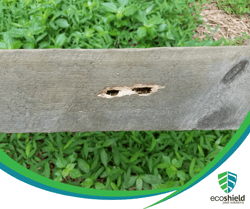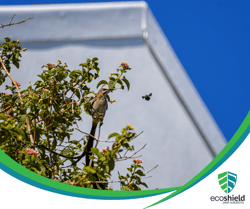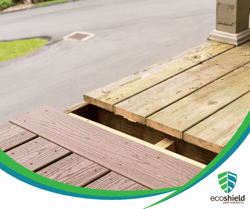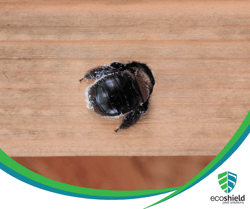 As springtime approaches, so does the buzzing presence of carpenter bees, potentially wreaking havoc in and around your home. These seemingly harmless insects can inflict significant damage, drilling perfectly round holes into the wood structures of your home. Luckily, proactive measures can be taken to prevent carpenter bee infestations and the subsequent structural harm they may cause. In this blog post, EcoShield explores effective strategies and practical tips for homeowners to safeguard their homes from these buzzing carpenter bee invaders. From identifying early signs of infestation to implementing preventive measures, let's embark on a journey to ensure your home remains a fortress against these wood-boring insects.
As springtime approaches, so does the buzzing presence of carpenter bees, potentially wreaking havoc in and around your home. These seemingly harmless insects can inflict significant damage, drilling perfectly round holes into the wood structures of your home. Luckily, proactive measures can be taken to prevent carpenter bee infestations and the subsequent structural harm they may cause. In this blog post, EcoShield explores effective strategies and practical tips for homeowners to safeguard their homes from these buzzing carpenter bee invaders. From identifying early signs of infestation to implementing preventive measures, let's embark on a journey to ensure your home remains a fortress against these wood-boring insects.
What kind of damage can carpenter bees cause to my home?
Carpenter bees, while seemingly innocuous, have the potential to inflict significant damage to your home. One of the primary concerns lies in their nesting habits. These industrious insects create tunnels within wood, typically opting for unpainted or weathered surfaces. The entrance holes they bore, though initially small, can lead to extensive structural issues over time. The tunnels they excavate weaken the integrity of wooden components, such as fascia boards, decks, and eaves, making them susceptible to further damage from environmental factors like rain and wind.
 Moreover, the damage caused by carpenter bees extends beyond the immediate structural compromise. Left unchecked, their nesting activities attract other wood-damaging pests and fungi, exacerbating the overall deterioration of the affected areas. The cosmetic impact is undeniable as well, with unsightly holes and stains marring the aesthetic appeal of your home. From a resale perspective, this damage can significantly reduce property value and curb appeal.
Moreover, the damage caused by carpenter bees extends beyond the immediate structural compromise. Left unchecked, their nesting activities attract other wood-damaging pests and fungi, exacerbating the overall deterioration of the affected areas. The cosmetic impact is undeniable as well, with unsightly holes and stains marring the aesthetic appeal of your home. From a resale perspective, this damage can significantly reduce property value and curb appeal.
It's essential for homeowners to recognize the potential consequences of carpenter bee infestations and take proactive measures to prevent and mitigate their impact. Regular inspections, timely repairs, and protective treatments are crucial in preserving the structural integrity and aesthetics of your home, ensuring it remains a secure and comfortable living space for years to come.
What are the signs of a carpenter bee infestation?
Detecting a carpenter bee infestation requires keen observation of certain subtle yet telling signs. One noticeable indicator is the presence of perfectly round, dime-sized holes in wooden structures around your home. These holes serve as entry points for carpenter bees, as they meticulously drill into the wood to create nesting galleries.
Additionally, you may observe sawdust-like frass, which is the residue of wood particles expelled by the bees during their tunneling activities. This fine powdery substance often accumulates beneath the entry holes or on nearby surfaces.
 Another red flag is the sight of carpenter bees hovering around the exterior of your home, especially during the warmer months when they are most active. Male carpenter bees are particularly territorial and may exhibit aggressive behavior to protect their nesting sites.
Another red flag is the sight of carpenter bees hovering around the exterior of your home, especially during the warmer months when they are most active. Male carpenter bees are particularly territorial and may exhibit aggressive behavior to protect their nesting sites.
Furthermore, if you notice irregular patterns or stains on the exterior surfaces of wood, it could be a sign of carpenter bee activity, as they often excrete waste materials while tunneling. Timely recognition of these signs is crucial for implementing effective prevention measures and mitigating potential structural damage caused by carpenter bee infestations.
Are carpenter bees dangerous to people or pets?
Carpenter bees, while possessing the ability to cause structural damage to wooden components of homes, are generally not considered dangerous to people or pets. These solitary bees are more interested in creating nests and foraging for pollen than engaging in aggressive behavior. Unlike their stinging counterparts, such as wasps or honeybees, male carpenter bees lack stingers altogether, rendering them unable to deliver painful stings. Female carpenter bees, which are equipped with stingers, are less likely to use them for defense unless directly provoked. Therefore, the risk of carpenter bee stings is minimal, and these insects are unlikely to pose a threat to the well-being of humans or pets.
It's worth noting that carpenter bees are generally docile and go about their activities without seeking confrontation. While they may seem intimidating due to their size, their primary focus is on nesting and pollination. However, if a person or pet were to inadvertently disturb a nesting site or engage in threatening behavior, a female carpenter bee might defensively use her stinger. Nevertheless, such instances are rare, and the majority of interactions with carpenter bees involve observing their fascinating behavior from a safe distance.
In conclusion, while carpenter bees may be capable of causing damage to wooden structures, they are not inherently dangerous to people or pets. Understanding their behavior and taking appropriate precautions can help homeowners coexist peacefully with these industrious insects without undue concern for the safety of their families or furry friends.
Can I prevent carpenter bees from damaging my home and property?
Absolutely, you can take proactive steps to prevent carpenter bees from causing damage to your home. Carpenter bees are attracted to untreated or unpainted wood, so one effective measure is to regularly inspect and treat wooden structures around your home. Applying a protective coat of paint or wood sealant acts as a deterrent, making the wood less appealing to these insects. Additionally, filling and sealing existing carpenter bee holes with wood putty helps discourage their return, as they tend to revisit previous nesting sites.
 Furthermore, consider using hardwoods like cedar or pressure-treated lumber for outdoor structures, as they are less susceptible to carpenter bee infestations. Another preventive approach involves placing screens or mesh over vulnerable areas, such as vents and openings, to block access points for these insects. If possible, opt for synthetic materials or composite wood alternatives in high-risk areas, as they are less attractive to carpenter bees.
Furthermore, consider using hardwoods like cedar or pressure-treated lumber for outdoor structures, as they are less susceptible to carpenter bee infestations. Another preventive approach involves placing screens or mesh over vulnerable areas, such as vents and openings, to block access points for these insects. If possible, opt for synthetic materials or composite wood alternatives in high-risk areas, as they are less attractive to carpenter bees.
In terms of landscaping, strategically place plants that carpenter bees find less appealing, such as those with strong fragrances or rough textures. Regularly trim and maintain vegetation around your home to eliminate potential nesting sites. Additionally, professional pest control services can provide specialized treatments to create a barrier against carpenter bees, offering an extra layer of defense. By adopting a combination of these strategies, you can significantly reduce the risk of carpenter bee damage to your home.
What should I do if I have carpenter bee infestation?
Discovering a carpenter bee infestation can be concerning, but prompt action is crucial to mitigate potential damage. The first step involves identifying the presence of these insects. Look for perfectly round holes, about half an inch in diameter, usually found on wooden surfaces such as eaves, decks, or siding. Once identified, it's advisable to consult with a pest control professional for a thorough assessment. These experts can determine the extent of the infestation and recommend appropriate measures.
 To address an existing carpenter bee infestation, one common method involves treating the drilled holes with insecticidal dust. This powder is introduced into the openings, effectively reaching the galleries where carpenter bees lay their eggs. Sealing the holes after treatment is essential to prevent future infestations. It's important to note that tackling carpenter bees can be challenging, and professional assistance is recommended for safe and effective eradication.
To address an existing carpenter bee infestation, one common method involves treating the drilled holes with insecticidal dust. This powder is introduced into the openings, effectively reaching the galleries where carpenter bees lay their eggs. Sealing the holes after treatment is essential to prevent future infestations. It's important to note that tackling carpenter bees can be challenging, and professional assistance is recommended for safe and effective eradication.
In addition to targeted treatment, consider making your property less attractive to carpenter bees by applying wood preservatives or painting exposed wooden surfaces. Opt for hardwoods or pressure-treated lumber for outdoor structures, as they are less appealing to these wood-boring insects. Regular maintenance, such as repainting and repairing damaged wood, is a proactive measure to deter carpenter bees from selecting your home as their nesting site.
In conclusion, confronting a carpenter bee infestation requires a multi-faceted approach. Identifying the issue, seeking professional guidance, and implementing targeted treatments are essential steps to safeguard your home. Furthermore, adopting preventive measures to make your property less inviting to carpenter bees is a wise investment in long-term protection. Swift and informed action can help you reclaim your home from these wood-boring invaders and ensure the structural integrity of your property.
Can EcoShield Pest Solutions prevent or remove carpenter bees?
 If you’re experiencing an active carpenter bee infestation or want to take a proactive approach to carpenter bee prevention, contact EcoShield today. Our knowledgeable pest technicians are standing by to provide you with customized pest treatment plans and expert guidance on how to achieve your goals of a carpenter bee-free home and property.
If you’re experiencing an active carpenter bee infestation or want to take a proactive approach to carpenter bee prevention, contact EcoShield today. Our knowledgeable pest technicians are standing by to provide you with customized pest treatment plans and expert guidance on how to achieve your goals of a carpenter bee-free home and property.
EcoShield offers our highly specialized Carpenter Bee Shield service to remove carpenter bees and to protect your home from costly carpenter bee damage. Ask about EcoShield’s carpenter bee service options today!